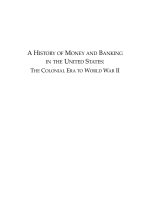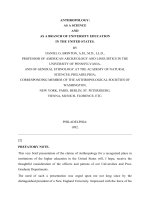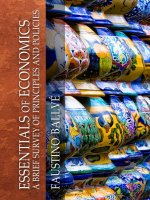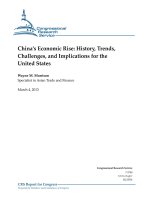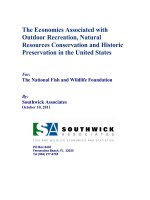A BRIEF HISTORY OF PANICS AND THEIR PERIODICAL OCCURRENCE IN THE UNITED STATES pdf
Bạn đang xem bản rút gọn của tài liệu. Xem và tải ngay bản đầy đủ của tài liệu tại đây (457.35 KB, 172 trang )
A BRIEF HISTORY OF PANICS
AND THEIR PERIODICAL OCCURRENCE IN THE
UNITED STATES
BY CLEMENT JUGLAR
MEMBER OF THE INSTITUTE, VICE-PRESIDENT OF
LA SOCIETE
D'ECONOMIE POLITIQUE
THIRD EDITION
TRANSLATED AND EDITED WITH AN
INTRODUCTION AND
BROUGHT DOWN FROM 1889 TO DATE
BY DECOURCY W. THOM
FORMER MEMBER OF THE BALTIMORE STOCK
EXCHANGE AND OF THE
CONSOLIDATED EXCHANGE OF NEW YORK
TO GOLDEN DAYS
Tonight at "Blakeford," I set down this dedication of the third edition
of this book which has proved to be the pleasant companion of two
visitations one at "Wakefield Manor," Rappahannock County, Virginia, in
1891, the other at my old home "Blakeford," Queen Anne's County,
Maryland, in 1915. The memories that entwine it there, and here mingle
in perfect keeping and have made of a dry study something that stirs
anew within me as I consider the work accomplished, my love and
remembrance of the old days, and my love and unforgettingness of these
other golden days under whose spell I have brought the book up to the
present year.
DECOURCY W. THOM.
"BLAKEFORD,"
October 10, 1915.
PREFACE TO THIRD EDITION
The second edition of this study of _Panics in the United States_
brought us through the year 1891. I originated about one fourth of it.
This third edition brings us practically up to date. Of this edition I
originated about one half. I hope it will prove helpful in many ways. I
trust that it will force an appreciable number of men to realize that
"business" or "financial" panic is not merely fear, as some have
asserted; but is based upon the knowledge that constriction, oppression,
unhappy and radical change in this, that, or the other kind of business
must tend to drag down many others successively, just as a whole line of
bricks standing on end and a few inches apart will fall if an end one is
toppled upon its next neighbor. Indeed, the major cause of "business" or
"financial" panic is just reasoning upon existing conditions rather than
a foolish fear of them. Over-trading and loss of nerve constitute the
medium. Recent national legislation has gone far in enabling the
business world in the United States to prevent panics, and farther yet
in providing the means to cope with them when, in spite of precautions,
they shall recur.
DEC. W. THOM.
"BLAKEFORD,"
October 10, 1915.
A BRIEF HISTORY OF PANICS
INTRODUCTION
COMPRISING A CONDENSATION OF THE THEORY OF PANICS, BY M.
JUGLAR,
RENDERED INTO ENGLISH, WITH CERTAIN ADDITIONAL MATERIAL,
BY DECOURCY W. THOM.
In this translation, made with the author's consent, my chief object
being to convey his entire meaning, I have unhesitatingly rendered the
French very freely sometimes, and again very literally. Style has thus
suffered for the sake of clearness and brevity, necessary to secure and
retain the attention of readers of this class of books. This same
conciseness has also been imposed on our author by the inherent dryness
and minuteness of his faithful inquiry into hundreds of figures, tables
showing the condition of banks at the time of various panics, etc.,
etc., essential to his demonstration. As an extreme instance of the
latitude I have sometimes allowed myself, I cite my rendering of the
title: "_Des Crises Commerciales et de Leur Retour Periodique en
France, en Angleterre et aux Etats-Unis_" merely as "Panics and Their
Periodical Occurrence in the United States": for M. Juglar himself
states that a commercial panic is always a financial panic, as a falling
away of the metallic reserve indicates its breaking out; and I have only
translated that portion dealing with the United States, deeming the rest
unnecessary, for this amply illustrates and proves the theorem in hand.
To this sketch of the financial history of the United States up to 1889,
when M. Juglar published his second edition, I have added a brief
account to date, including the panic of 1890, the table headed "National
Banks of the United States," and some additions to the other tables
scattered through this book.
From the prefaces to the French editions of 1860 and of 1889, and other
introductory matter, I have condensed his theory as follows:
A Crisis or Panic may be defined as a stoppage of the rise of prices:
that is to say, the period when new buyers are not to be found. It is
always accompanied by a reactionary movement in prices.
A panic may be broadly stated as due to overtrading, which causes
general business to need more than the available capital, thus producing
general lack of credit. Its precipitating causes are broadly anything
leading to overtrading:
In the United States they may be classed as follows:
I. PANICS OF CIRCULATION, as in 1857, when the steadily increased
circulation, which had almost doubled in nine years, had rendered it
very easy to grant excessive discounts and loans, which had thus
over-stimulated business, so that the above relapse occurred; or, we may
imagine the converse case, leading to a quicker and even greater
disaster: a sudden and proportionate shrinkage of circulation, which, of
course, would have fatally cut down loans and discounts, and so
precipitated general ruin.
2. A PANIC OF CREDIT, as in 1866, when the failure of Overend, Gurney, &
Co. rendered the whole business world over cautious, and led to a
universal shrinkage of credit. [I take the liberty of adding that it
seems evident to me that such a danger must soon confront us in the
United States, unless our Silver Law is changed, because of a finally
inevitable distrust of the government's ability to keep 67-cent silver
dollars on an equality with 100-cent gold dollars.]
3. PANICS OF CAPITAL, as in 1847, when capital was so locked up in
internal improvements as to prove largely useless.
4. GENERAL TARIFF CHANGES. To the three causes given above the
translator adds a fourth and most important one: Any change in our
tariff laws general enough to rise to the dignity of a new tariff has
with one exception in our history precipitated a panic. This exception
is the tariff of 1846, which was for revenue only, and introduced after
long notice and upon a graduated scale. This had put the nation at large
in such good condition that when the apparently inevitable Decennial
Panic occurred in 1848 recovery from it was very speedy.
The reason for this general effect of new tariffs is obvious. Usual
prices and confidence are so disturbed that buyers either hold off,
keeping their money available, or else draw unusually large amounts so
as to buy stock before adverse tariff changes, thus tightening money in
both ways by interfering with its accustomed circulation. This tendency
towards contraction spreads and induces further withdrawal of deposits,
thus requiring the banks to reduce their loans; and so runs on and on to
increasing discomfort and uneasiness until panic is speedily produced.
The practical coincidence and significance of our tariff changes and
panics is shown by an extract below from an article written by the
translator in October-November, 1890, predicting the recent panic which
was hastened somewhat by the Baring collapse. [Footnote:
_Inter-relations of Tariffs, Panics, and the Condition of Agriculture,
as Developed in the History of the United States of America_.
This brief sketch of our economic history in the United States seeks to
show that Protective Tariffs have always impoverished a majority of our
people, the Agriculturists; that agriculture has thus been made a most
unprofitable vocation throughout the States, and that this unsoundness
at the very foundation of the business of the American people has often
forced our finances into such makeshift conditions, that under any
unusual financial strain a panic, with all its wretched accompaniments,
has resulted.
To consider this properly, we must note the well known fact that in this
land, those who live by agriculture directly, are more than one half of
our population. Their votes can cause to be made such laws as they see
fit, hence, one would expect the enactment of laws to raise the price of
farm products, and to lower the price of all that the farmer has to buy.
But the farmers vote as the manufacturers and other active classes of
the minority of our voters may influence; and only twice in our history,
from 1789 to 1808, and from 1846 to 1860, have enough of the minority
found their interests sufficiently identical with that of the
unorganized farmer-majority to join votes, and thus secure at once their
common end. In consequence of this coalition during these two periods,
two remarkable things happened: 1st, agriculture flourished, and
comfortable living was more widely spread: 2d, panics were very
infrequent, and the hardships and far-reaching discomforts that must
ever attend adjustments to new financial conditions after disturbances
were, of course, minimized.
It is not fair to deduce very much from the first period of prosperity
among the farmers, 1789 to 1808, for, during this time, there were no
important business interests unconnected with agriculture; but we may
summarize the facts that from 1789 to 1808, there was, 1st, no
protection, the average duty during this time being 5 per cent., and
that laid for revenue only; 2d, that agriculture flourished; 3d, that
there was not a single panic.
"The Embargo" of 1808, followed by the Non-Intercourse Act in 1809 and
the War of 1812-15, and the war tariff, by which double duties were
charged in order to raise money for war purposes, caused us to suffer
all the economic disasters flowing from tariffs ranging between absolute
protection, and those practically prohibiting, and intensified by the
sufferings inseparable from war.
During this period agriculture, for the first time in our history, was
in a miserable condition. It is significant that for the first time too,
we had a protective tariff. Though our people made heroic efforts to
make for themselves those articles formerly imported, thus starting our
manufacturing interests, they had, of course, lost their export trade
and its profits. When the peace of 1814 came, we again began exporting
our produce, and aided by the short harvests abroad, and our own
accumulated crops, resumed the profitable business which for six years
our farmers and our people generally had entirely lost. Our first panic,
that of 1814, came as a result of our long exclusion from foreign
markets, being followed by the stimulation given business through
resumption of our foreign trade in 1814, which was immensely heightened
by the banks issuing enormous quantities of irredeemable paper, instead
of bending all their energies to paying off the paper they had issued
during the war.
But worse than the suffering entailed by this panic, was the engrafting
upon our economic policy of the fallacious theory made possible by the
Embargo and the Non-Intercourse Act, (which was equivalent, let me
enforce it once more, to that highest protective tariff, a prohibitory
one) that _all infant manufactures must be protected, that is,
guaranteed a home market_, though such home market be one where all
goods cost more to the purchaser than similar goods bought elsewhere,
and this in order that the compact little band of sellers in the home
market may make their profit. This demand for protection was made by
those who had started manufactures during the years from 1808 to the end
of the war of 1815, when, as we have seen, imports were practically
excluded.
In 1816 their demand met explicit assent, for, in the tariff of that
year, duty for protection, not for revenue, was granted; and an average
of 25 per cent. duties for six years, to be followed by an average of 20
per cent. duties, was laid upon imports. For a few years bad bread crops
in Europe, demand for our cotton, and an inflation of our currency
delayed a panic.
But, we had started on our unreasoning course. We had tried to ignore
the laws of demand and supply, and had forgotten that it is also
artificial to attempt preventing purchases in the cheapest, and selling
in the highest markets; and to help a few manufacturers we had put up
prices for all that a large majority of our population, the
agriculturists mainly had to buy. In a short while the demand for what
the farmers had to sell fell away, and bills could not be met, and their
troubles were added to those of the minority of the consumers of the
country; the volume of business fell off, and a panic came in 1818. The
influences that led up to it continued until 1846, as follows: The great
factors in producing this state of affairs were the successive tariffs
of 1818, with its 25 per cent. duty upon cottons and woollens, and its
increased duties on all forms of manufactured iron, (the tariff of 1824
which increased duties considerably), and the tariff of 1828, imposing
an average of 50 per cent. duties, and in which the protective movement
reached its acme (omitting, of course, the present McKinley Bill with
its 60 per cent. average duty). In 1832, consequently, a great reaction
in sentiment took place, and the "Compromise Tariff" was passed and
duties were lowered. From this period, the advocacy of a high tariff in
order to protect "Infant Industries," no longer "Infant" was largely
abandoned, and its advocacy was generally based upon the fallacy, less
obvious then than now, of securing high wages to laborers by means of
high import duties. This plea for high duties the laborer found to be
fallacious.
They (agriculturists mainly) found that they had to pay more for
manufactured goods, so that the manufacturers could still buy their raw
materials at the advanced prices, pay themselves the accustomed or
increased profits, and then possibly pay the laborer a small advance in
wages.
The advance did not compensate for increased cost of necessaries of
life. If competition reduced the manufacturers' profit, the first
reduction of expenses was always in the laborer's pay. The recognition
of these truths brought about the further reduction of duties until
1842, in which year the tariff was once more raised. It was not until
1846 that we enjoyed a tariff which sought to eliminate the protective
features. It is significant that a period of greater profit and
stability among our business men, but especially among our farmers, was
then inaugurated. This was the first tariff, since that of 1816, not
affected by politics. It lasted-until 1857, and the country flourished
marvellously under it.
From 1816, when protection was first resorted to, until today, tariff
rates have been almost continually raised, mainly by votes of the
agriculturists, misled by the manufacturers and politicians, influenced
by the manufacturers' money. And a fact worth noting is that financial
panics have come quick and furious. They came in 1818, and in 1825-26,
in 1829-30, and so on, (see page 13). Sudden changes in our tariff rates
have unvaryingly been followed by financial panics within a short
period. Changes to lower rates have not brought panics so quickly as
changes in the reverse direction.
Low tariff without protective features, maintained steadily, has been
coincident with constantly increasing prosperity to the country at
large: but most especially to the agriculturists. This is readily
understood, for purchases of imported and manufactured goods and all
outfit needed for the farmers' land and family can be made at low and
owing to the competition that always arises to supply a steady and
natural market lowering prices. Moreover, the settled prices prevailing
throughout the country allow of assured calculations and precautions as
to business ventures, and permit such a ratio to be established between
expenses and income, that at the end of the fiscal year a profit, not a
loss, may be counted upon.
This was the experience of our agriculturists during the second and last
prosperous time of our farmers, 1846-60. During that period agriculture
flourished; the tariff was low and there were only two panics, that of
1848, and the one of 1857, and the first (a non-protective one) should
not be considered as precipitated by the tariff of 1846, except that
some few suffered briefly in readjusting themselves to the changed,
(though better), condition of the new tariff. The vast majority of the
nation reaped enormous benefits from the changes inaugurated.
The panic of 1857 was caused by over-activity in trade speculation, and
over-banking, and the tariff of the same year was really passed to help
avert the panic threatening. It had the contrary effect, it is believed,
for it still further, of course, unsettled rates for goods, when prices
were already unstable. But the point is to be noted that in reality
tariff change followed practical panic in this instance rather than
practical panic tariff change. The high protective war tariffs,
beginning in 1860, and increased for war purposes and granted largely as
an offset for those internal revenue taxes laid to carry on the war,
have been continued as a body ever since, as is well known, despite the
internal revenue taxes having been abolished except on whiskey and
tobacco. It is equally well known that farming has grown less and less
remunerative since 1860, and that the panics of 1864, 1873, and 1884
have been unfortunate culminations of almost unceasing financial
discomfort, which has been most forcibly exemplified during the last two
months. Even now the financial fabric is in unstable equilibrium, and
this latest monstrosity the McKinley Bill imposing the highest tariff
we have ever exacted an average duty of 60 per cent., and coming when a
panic was due, bids fair to hurry us into another and a terrible
financial panic. If it does not do so, it will be because our crops are
too bountiful to allow it, but it will at least have made the
agriculturists and all buyers of other commodities than agricultural
produce pay more for all purchases. It will bring no more money into
their pockets, but it must take out considerably more. The people
appreciate this. The nation's pocket nerve has been touched. This is the
meaning of the recent election, it seems to the writer. But whether the
impending danger can be averted even if a prompt, though wise and slow
reversal of tariff policy can be forced by the next Congress is
doubtful, for unrest and timidity have been evoked and require time to
be allayed before easy and orderly business operations will in general
be resumed, unless indeed bountiful crops here and demand abroad once
again reverse the logic of the situation.
Certain it is that our tariff laws must interfere as little as possible
with the natural law of demand and supply in making prices, or we must
be content to suffer from the instability that artificiality always
brings with it.
Our plain duty is to enact as speedily as possible a tariff that shall
by small but continued changes cut down our protective duties and
substitute non-protective duties until our tariff is for revenue only;
for thus and thus only can the vast majority of the agriculturists buy
what they need most cheaply, and so find that to purchase necessaries
does not cost them more than the total of their sales; and our exports
of produce, chiefly owing to agricultural prosperity, would increase,
thus materially helping to build up our general business so that the
other nations will have to pay us, in the gold we require for
comfortable management of our business, the growing trade balances
against them.
The rough table below suggests that sudden tariff changes have
precipitated panics, which have come quickly if the change was to higher
protective duties and somewhat slower if the change was to lower
protective duties; that slow and well considered changes doing away with
protective duties generally have not caused disturbances; and that
agriculture has flourished in proportion as we approached tariff for
revenue only. It has for obvious reasons required about one year for
financial trouble to be shown by decrease in value of farm produce as
evinced by wheat-flour exports.
Special conditions, such as excessive wheat corps here and deficiency
abroad or special tariff favors to flour export, may even increase the
amount exported despite an otherwise untoward effect of the new tariff
upon farmers. I have selected flour exports as the article best
reflecting the chief interest of the farmers, and at the same time the
state of general business for manufacturing, transportation and such
other branches as are concerned with it.
+ +
TARIFFS ,- They have all | | Condition of agriculture and
| been designedly | | incidentally of general
+ protective | Panics. | business as suggested by export
| save the one | | of wheat flour from 1790-1890.
'- of 1846. + +
| | Year. Barrels. Dollars.
| | 1790 724,623 4,591,293
| | 1791 619,681 3,408,246
| | 1792 824,464
| | 1793 1,074,639
| | 1794 846,010
| | 1795 687,369
| | 1796 725,194
| | 1797 515,633
| | 1798 567,558
| | 1799 519,265
| | 1800 653,056
| | 1801 1,102,444
| | 1802 1,156,248
| | 1803 1,311,853 9,310,000
| | 1804 810,008 7,100,000
| | 1805 777,513 8,325,000
| | 1806 782,724 6,867,000
| | 1807 1,249,819 10,753,000
| | 1808 263,813 1,936,000
| | 1809 846,247 5,944,000
| | 1810 798,431 6,846,000
,- Practical | | 1811 1,445,012 14,662,000
| exclusion of | | ,- 1812 1,443,492 13,687,000
Say + all imports | | | 1813 1,260,943 13,591,000
1814 | through the war = | 1814 | + 1814 193,274 1,734,000
'- Prohibitory Tariff. | | '- 1815 862,739 7,209,000
| | ,- 1816 729,053 7,712,000
,- Duties for six | | '- 1817 1,479,198 17,751,376
1816 + years @ 25% and | 1818 | ,- 1818 1,157,697 11,576,970
'- thereafter @ 20%. | | | 1819 750,669 6,005,280
| | | 1820 1,177,036 5,296,664
1818 ,- Duties 25% on | | | 1821 1,056,119 4,298,043
| Cotton and Woollens, | | + 1822 827,865 5,103,280
+ and all duties | | | 1823 756,702 4,962,373
| on Manufactured | | | 1824 996,792 5,759,176
'- Iron increased. | 1825-26 | | 1825 813,906 4,212,127
| | | 1826 857,820 4,121,466
| | '- 1827 868,492 4,420,081
| | ,- 1828 860,809 4,286,939
1828 { Average duty of 50%. | | | 1829 837,385 5,793,651
| | + 1830 1,227,434 6,085,953
| | | 1831 1,806,529 9,938,458
| | '- 1832 864,919 4,880,623
,- Compromise Tariff, | | ,- 1833 955,768 5,613,010
| gradual reduction | | | 1834 835,352 4,520,781
| of duties from | | | 1835 779,396 4,394,777
| 50% average until | | | 1836 505,400 3,572,599
1833 + in 1842 the average | 1836-39 | + 1837 318,719 2,987,269
| was 20%. But this | | | 1838 448,161 3,603,299
| was levied for | | | 1839 923,151 6,925,170
| Protection not | | | 1840 1,897,501 10,143,615
'- merely for Revenue. | | '- 1841 1,515,817 7,759,646
| | ,- 1842 1,283,602 7,375,356
1842 {Imposed higher duties. | | + 1843 841,474 3,763,073
| | | 1844 1,438,574 6,759,488
| | '- 1845 1,195,230 5,398,593
| | ,- 1846 2,289,476 11,668,669
,- Imposed lower | | | 1847 4,382,496 26,133,811
| duties and these | | | 1848 2,119,393 13,194,109
1846 | were not for | | | 1849 2,108,013 11,280,582
+ Protection purposes, | | | 1850 1,385,448 7,098,570
| they were simply | 1848 | + 1851 2,202,335 10,524,331
'- for Revenue. | | | 1852 2,799,339 11,869,143
| | | 1853 2,920,918 14,783,394
,- Reduced Tariff | | | 1854 4,022,386 27,701,444
| rates on above | | | 1855 1,204,540 10,896,908
1857 + plan because of | | '- 1856 3,510,626 29,275,148
| redundant | | ,- 1857 3,712,053 25,882,316
'- prosperity. | 1857 | + 1858 3,512,169 19,328,884
| | '- 1859 2,431,824 14,433,591
,- War Tariff | |
| protection restored | | ,- 1860 2,611,596 15,448,507
1860 + as compensation for | 1864 | '- 1861 4,323,756 24,645,849
| Internal Revenue | |
'- taxes. | |
| |
1862 As above | | 1862 4,882,033 27,534,677
1864 As above | | 1863 4,390,055 28,366,069
| | ,- 1864 3,557,347 25,588,249
| | | 1865 2,641,298 27,507,084
| | | 1866 2,183,050 18,396,686
| | + 1867 1,300,106 12,803,775
| | | 1868 2,076,423 20,887,798
| | | 1869 2,431,873 18,813,865
,- 10% reduction, but | | | 1870 3,463,333 21,169,593
| coffee and tea put | | '- 1871 3,653,841 24,093,184
1872 + on Free List and | | ,- 1872 2,514,535 17,955,684
| whiskey and tobacco | 1873 | | 1873 2,562,086 19,381,664
'- taxes reduced. | | | 1874 4,094,094 29,258,094
| | | 1875 3,973,128 23,712,440
1875 ,- 10% reduction | | | 1876 3,935,512 24,433,470
'- above repealed. | | + 1877 3,343,665 21,663,947
| | | 1878 3,947,333 25,695,721
| | | 1879 5,629,714 29,567,713
| | | 1880 6,011,419 35,333,197
,- Duties really raised | | | 1881 7,945,786 45,047,257
| on class of goods | | '- 1882 5,915,686 36,375,055
| most used, but | | ,- 1883 9,205,664 54,824,459
| apparently lowered | 1884 | | 1884 9,152,260 51,139,695
1883 + the tariff, for | | | 1885 10,648,145 52,146,336
| it considerably | | + 1886 8,179,241 38,443,955
| reduced rates on | | | 1887 11,518,449 51,950,082
| many little used | | | 1888 11,963,574 54,777,710
'- classes of goods. | | '- 1889 9,374,803 45,296,485
| |
1890 ,- McKinley Bill | | ,- 1890 12,231,711 57,036,168
'- average of 60% duty. | | '- 1891 11,344,304 54,705,616
| | 1892 15,196,769 75,362,283
,- Free silver | |
| and sudden | | 1893 16,620,339 75,494,347
1893 + ill-distributed | | 1894 16,859,533 69,271,770
-94 | and drastic tariff | | 1895 15,268,892 51,651,928
| reductions and | | 1896 14,620,864 52,025,217
'- insufficient revenue.| |
| | 1897 14,569,545 55,914,347
1897 ,- | | 1898 15,349,943 69,263,718
| Tariff | | 1899 18,485,690 73,093,870
| disturbance | | 1900 18,699,194 67,760,886
| to | | 1901 18,650,979 69,459,296
| higher | | 1902 17,759,203 65,661,974
1903 | rates. | | 1903 19,716,203 73,756,404
| | | 1904 16,699,432 68,894,836
+ The | | 1905 8,826,335 40,176,136
| propaganda | | 1906 13,919,048 59,106,869
1907 | for | | 1907 15,584,667 62,175,397
| keener | | 1908 13,937,247 64,170,508
| regulation | | 1909 10,521,161 51,157,366
| of | | 1910 9,040,987 47,621,467
| business. | | 1911 10,129,435 49,386,946
'- | | 1912 11,006,487 50,999,797
| |
1913 ,- Tariff reductions to | | 1913 11,394,805 53,171,537
| produce a revenue; | | 1914 12,768,073 62,391,503
| not on a protective | |
+ basis. The further | |
| regulating of | |
| business. | |
'- The "World War." | |
+ + ]
The retarding or precipitating influence of a good or bad condition of
agriculture upon the advent of a panic is also indicated.
The symptoms of approaching panic, generally patent to every one, are
wonderful prosperity as indicated by very numerous enterprises and
schemes of all sorts, by a rise in the price of all commodities, of
land, of houses, etc., etc., by an active request for workmen, a rise in
salaries, a lowering of interest, by the gullibility of the public, by a
general taste for speculating in order to grow rich at once, by a
growing luxury leading to excessive expenditures, a very large amount of
discounts and loans and bank notes [Footnote: Our recent banking history
has proved rather an exception to this law as far as bank notes are
concerned, because of the obviously unusual cause of sudden and enormous
calling in of government bonds, the basis of bank-note issue.] and a
very small reserve in specie and legal-tender notes and poor and
decreasing deposits.
On the other hand, the lowest point of depression following a panic is
accompanied by the converse of the symptoms just enumerated.
Bank balance sheets reflect in cold figures the result of the above
influences. Prices being high, and discounts and loans large in
proportion to deposits, and having steadily increased for years, danger
is near; further, when discounts and loans are not only large in
proportion to deposits, having increased steadily for years, and then
suddenly fallen off noticeably for a considerable time, only to increase
again, danger is imminent.
On the other hand, a steady and radical reduction of loans and
discounts, following a panic and extending until new enterprises are
very scarce, till prices are very low, till there is wide-spread
idleness among workmen, a decrease in salaries and in interest rates,
when the public is wary and speculation dead, and expenditures are cut
down as far as possible, may be taken to mean a rapid and continued
resumption of every prosperous business: but if the above process is
only partially performed, renewed trouble must result; in other words,
liquidation to really be helpful (to congested business) must be
thorough.
A study of the first of the following tables, "National Banks of the
United States," illustrates the above generalization. It is unnecessary
to mention that 1878, 1884, and 1890 have been the last three panic
years. But it is very necessary in studying this table, to bear in mind
that its figures are taken from the standing of the banks at the first
of the year, while the panics generally occurred later in the year: the
last two, for instance in the second and fourth quarter, respectively.
The third and fourth tables will give more exact figures in this
connection. Table Two, dealing with State Banks, is given merely to
round out our banking history as told in figures.
The increase or diminution of deposits of course reflects a confident
and successful, or a panicky and impoverishing, state of general
business.
TABLE NO. 1 NATIONAL BANKS OF THE UNITED STATES
_____________________________________________________________________
____
Percentage of Difference (over or under) |
between Deposits and Loans and Discounts. |
________________________________________________________________ \
|
